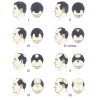The Impact of Androgenic Alopecia on the Quality of Life of Male Individuals: A Cross-Sectional Study
- PMID: 38021524
- PMCID: PMC10676293
- DOI: 10.7759/cureus.47760
The Impact of Androgenic Alopecia on the Quality of Life of Male Individuals: A Cross-Sectional Study
Abstract
Background Hair plays a significant role in physical appearance and hair loss can profoundly affect self-esteem and mental health. Studies show that people with clinically obvious and undetectable hair loss may have dramatically decreased quality of life (QoL). This study investigated the impact of androgenic alopecia on the quality of life of male individuals in the Eastern Province of Saudi Arabia and their willingness to seek treatment. Methods In the eastern province of Saudi Arabia, a cross-sectional study was carried out among men identified with androgenic alopecia (AGA). A self-administered survey was disseminated among the patients through social media sites. The questionnaire includes fundamental demographic factors including age, place of residence, level of education, the severity of androgenic alopecia, treatment method, and Skindex-29 to assess the patient's quality of life. Results Four hundred-two male patients out of 717 participants were selected, and 158 (39.3%) were aged between 20 to 29 years old. Satisfaction with treatment medication was reported by 24 (19.5%) out of those who underwent treatment (n=123). Less effectiveness was the most common reason for treatment dissatisfaction (81, 81.8%). The overall mean Skindex-29 score was 23.2 (SD 19.6) out of 100 points. Younger age, suffering hair loss for a shorter duration, undergoing alopecia treatment, being diagnosed with alopecia by a medical doctor, and having a moderate level of AGA were the factors that greatly affected the patient's QoL. Conclusion Consistent with the literature, this study showed that AGA significantly impaired patients' QoL. Among QoL domains, the symptoms domain had a greater effect on patients than the emotions or functional domains. Younger males who were suffering recently from hair loss and were diagnosed with AGA by the medical doctor demonstrated greater QoL impairment than the rest of the patients. A multicenter study may result in a better representation of the impact of QoL in patients with AGA.
Keywords: androgenic alopecia; hair loss; kingdom of saudi arabia (ksa); male patient; male pattern hair loss; psychological impact; quality of life (qol); self-esteem.
Copyright © 2023, Al Najjar et al.
Conflict of interest statement
The authors have declared that no competing interests exist.
Figures

References
-
- Quality of life in young men with androgenetic alopecia: a mixed methods study. Razum J, Vukasović Hlupić T. https://doi.org/10.1111/jocd.14132. J Cosmet Dermatol. 2022;21:794–801. - PubMed
-
- Clinical severity does not reliably predict quality of life in women with alopecia areata, telogen effluvium, or androgenic alopecia. Reid EE, Haley AC, Borovicka JH, Rademaker A, West DP, Colavincenzo M, Wickless H. https://doi.org/10.1016/j.jaad.2010.11.042. J Am Acad Dermatol. 2012;66:0–102. - PubMed
-
- Guidelines for the diagnosis and treatment of male-pattern and female-pattern hair loss, 2017 version. Manabe M, Tsuboi R, Itami S, et al. https://doi.org/10.1111/1346-8138.14470. J Dermatol. 2018;45:1031–1043. - PubMed
-
- Use of vitamins and minerals in the treatment of hair loss: a cross-sectional survey among dermatologists in Saudi Arabia. Mubki T. https://doi.org/10.2310/7750.2014.14008. J Cutan Med Surg. 2014;18:405–412. - PubMed
LinkOut - more resources
Full Text Sources
Miscellaneous
